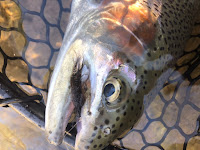Welcome to Soggy Saturday and Wet Weekdays. Our extended forecast features frequent rains, which are actually good news. Our streams and rivers are low and badly need a recharge. At least we’ll be spared from the Big Arctic Blast, which shouldn’t make it this far south. Stream temperatures are still pretty good, considering it’s mid-February!
https://waterdata.usgs.gov/ga/nwis/uv?site_no=02330450
This week savvy anglers will watch the weather and water and predict their windows of opportunity. If river flows are high, aim for Plan B, the small headwaters, ponds, and reservoir striper searches.
If the afternoon will be warm and the stream is clear, carry your dry fly boxes and some hope. And if you’re only tuning into our Friday fishing reports, you’ve missed some great intel in our preceding, daily posts. Scroll back and look at Rainbow Romance and Dropshotting. BOLO hatching bugs including

winter stones, BWO’s, midges, and maybe some early gray caddis if you’re real lucky. (Rumor also has it that there might be a FB page rod giveaway next week, too...)
Wes’ hot fly list this week is varied to reflect last week’s trip diversity. Nymphs & wets include fire egg, partridge soft hackles of various colors, purple lightning bug, and olive hares ear. Meaty streamers for river recons (for recently retired broods) are the sparkle minnow, barred mini-dungeon, and sculpzilla. Dries that worked on our recent, warm afternoons were #18 or #20 CDC comparadun BWO, same sized parachute Adams, and a #16 black stonefly. Wes said the small dries caught Smith DH fish that were taking small surface bugs on warm afternoons.
We have some great angler reports and hot intel to follow on our extended Facebook post. The clear winner in this week’s “fish story” competition has gotta be Sautee for his “blueline innovation.” Enjoy!
Headwaters
Hunter said, “I went with great friend Rodney Tumlin and did some bluelining the morning after the snow came through. I didn’t expect much with the cold weather but was still able to pick up a few brookies. Fish were deep, slow to move, and generally not too hungry unless you gave them something big enough they couldn’t turn down.”
To contrast the weather and fish response, Sautee scribed this fish story: “Tuesday afternoon was sunny with 60+ degree temps that spelled promise for rising fish on my favorite small stream. After getting done with projects and workmen around the house, I had enough time to slip out for a couple of hours. I got to the parking area about 3:15 and rigged up with a dry/dropper combo (October caddis dry with #16 beadhead hare’s ear dropper) that has worked well for me on this particular creek. Once my rig was ready and I got in my waders, I headed up the trail for about 10 minutes before dropping down to the creek.
When I got creekside, I quickly realized that I had left my dry fly floatant and dessicant back at the house. I was not happy! I quickly weighed my options which included: 1) losing the dry and fishing the dropper under a strike indicator, 2) placing the indicator near my dry to keep it topside and hoping it wouldn’t be too close to scare away any fish looking up, 3) fishing the dry/dropper “as is” and continuously drying my fly after every few casts in the hopes it would float, 4) make an attempt at euronymphing, although I knew fish would be watching the surface for bugs.
 But I had decided on the ride over to the creek that I was going to fish dry/dropper. I just couldn’t convince myself any other rig was gonna work as well. That’s when I got creative! What could help keep my caddis on top without causing too much angst in the trout? The only thing I could find in my pack that floated was my foam fly box and that, of course, was way too big....
But I had decided on the ride over to the creek that I was going to fish dry/dropper. I just couldn’t convince myself any other rig was gonna work as well. That’s when I got creative! What could help keep my caddis on top without causing too much angst in the trout? The only thing I could find in my pack that floated was my foam fly box and that, of course, was way too big....
 But wait! Maybe just a piece of it? Well, to get to the point, while streamside, I cut a piece of my fly box off, used my 6X tippet to tie it to my dry, and proceeded to fish dry/dropper for the next 2.5 hours. As it turned out, the local wild rainbows had no interest in my hare’s ear dropper. They did however take my dry occasionally and I brought several to hand that were looking up that evening. However, the most fish were caught when I switched my dropper to a #16 beadhead Y2K that took advantage of the active, hungry, spawning rainbows. I ended up with 18 to hand ranging from 4 to 10 inches. I’ve included a pic of my “caddis creative float application”
But wait! Maybe just a piece of it? Well, to get to the point, while streamside, I cut a piece of my fly box off, used my 6X tippet to tie it to my dry, and proceeded to fish dry/dropper for the next 2.5 hours. As it turned out, the local wild rainbows had no interest in my hare’s ear dropper. They did however take my dry occasionally and I brought several to hand that were looking up that evening. However, the most fish were caught when I switched my dropper to a #16 beadhead Y2K that took advantage of the active, hungry, spawning rainbows. I ended up with 18 to hand ranging from 4 to 10 inches. I’ve included a pic of my “caddis creative float application”
as a reminder to always pack and repack your gear to ensure you don’t have to cut your fly box up while out in the woods. However, it never hurts to stretch your brain while on the stream. Thanks for joining me on just another mountain misadventure!”
Dukes
Veteran Smithgall slugger Landon snagged a walk-on slot last weekend and made the most of his 3-hour tour before heading home to family commitments. He landed better than a dozen bows, including several hefty fish. He said the residents were eating leeches, rubberleg stones, and his soft hackle droppers on this quick trip.
Landon is a great example of an angler’s “home field advantage” at Smithgall. Experienced trouters like him first pay their dues, learn the stream while striking out early in their career, and eventually up their batting averages with more trips to the plate. Reservations: 706-878-3087 for your chance at a home run. Worry more about your technique than your fly pattern and you’ll get more hits.
Delayed Harvest
These Smith Creek reports are “borrowed” from North GA Trout Online, a great resource itself.
http://www.georgia-outdoors.com/forum
Hillis: “Dredger, thanks for the weekly report, always good intel and tips!! Following up on your intel about GAWRD redosing... Flies that worked for me yesterday afternoon on those freshly stocked trout at Smith were #12 and #14 Confusion Jig Nymphs
(very similar to Walts Worm), #12 pink squirmy, and #14 pink egg. Caught My biggest fish of the day yesterday on a # 10 Sexy Walts Worm. “
Scratch: “I'll supplement with a Smith's trip from Monday.
There were a surprisingly high number of cars in the parking lot at noon when I arrived, and the majority of fishers were focused on those pools by the bridge (dozens of trout there). Caught my biggest on a pink/orange #10 y2k. I ran through all of my y2k colors and caught 1-2 fish on each. I watched another guy catch about a dozen fish by the bridge drifting a pink san juan.
Up closer to the dam I fished a round of dry-droppers in the afternoon sun and had multiple strikes on #18/#20 zebra midges and WD40s (both black). Watched multiple trout follow the nymph to the surface at the end of the drift and that's where the strikes occurred.”
Note that Smith DH has been very crowded, even on weekdays, so plan accordingly.
Dredger hit the Chattooga DH on a warm Tuesday afternoon. Water temp was 46F at noon and rose to 48F by 5pm. He struck out via Euronymphing through the first hour. Then he saw a few fluttering stones and switched to dry/dropper.
The stones and risers were few and far between, with few fish convinced to leave their shady, predator-proof hideouts in the low, clear river to rise to his dry. He still caught a small handful of bows and browns. On top. In February.
 Conversely, SC buddy Todd whacked them while wading downstream and tossing a double streamer rig. Dredger crossed his path while fishing up. They compared notes and here are the tips from two old Hokies. If you want numbers, aim high or low for the fresh winter stockers. If you want some topwater action, look for fall survivors and fluttering bugs in the afternoon. Aim your dry/dropper rigs for the shallow flats in the middle of the DH section. We need “a good flush” of high river flow to spread out those new stockers.
Conversely, SC buddy Todd whacked them while wading downstream and tossing a double streamer rig. Dredger crossed his path while fishing up. They compared notes and here are the tips from two old Hokies. If you want numbers, aim high or low for the fresh winter stockers. If you want some topwater action, look for fall survivors and fluttering bugs in the afternoon. Aim your dry/dropper rigs for the shallow flats in the middle of the DH section. We need “a good flush” of high river flow to spread out those new stockers.
Private Waters
Palmer reported, “I had a Nacoochee Bend trip on Wednesday. The fish were extremely active and hungry. Eggs and legs and twitched buggers worked well. We also caught a lot of trout on the swing with soft hackles.
Lanier
HenryC checked in today, “Striper fishing is actually fair right now. The key is to properly pick your days to fish. You have to be flexible in order to have success. While there are lots of deep fish that fly fishers cannot catch, there’s also a fair number of fish on the surface or within reasonable depths when you fish around prefrontal weather or totally overcast weather. When it’s bluebird skies... stay home! Birds will help you find the fish; look in the creeks for single fish eating between the docks or wherever you see gulls over open water. The Something Else fly is easily your best fly of choice to match the threadfin shad prey.”
https://www.henrycowenflyfishing.com/
That’s the latest from “Flyfishing Central” in Helen, GA. Keep your distances, thank a nurse, and remember your raincoats this week!





























